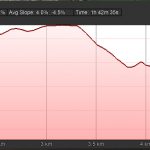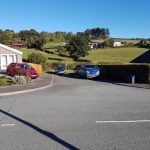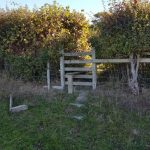Walk 14 Gwestydd
The walk starts and ends in the centre of Newtown. It is varied, and includes hard surfaced roads and unsurfaced tracks and footpaths. Some of the sections can be wet and muddy. There are good views over Newtown and the surrounding countryside.
4.3 miles • 2.2 hours • Easy
Images
Directions
1
This walk starts under the Town Clock at the junction of Broad St, High St and Severn St, the area known locally as ‘The Cross’. The building was erected by Sarah Brisco, a descendent of the Pryce family of Newtown Hall, to commemorate Queen Victoria’s Jubilee in 1897. Opposite the clock on Severn Street is the Robert Owen Museum and the Robert Owen Memorial Rooms are over the HSBC on the other corner. Robert Owen, the founder of the Co-operative Movement, is one of Newtown’s most famous sons.
Go along Broad St towards Longbridge and cross to the north side of the river. On the left you will see an attractive old building, Pont Hafren, now operating as a registered mental health charity, www.ponthafren.org.uk. At the roundabout turn right along Commercial Street which becomes Canal Road which you follow to pass the Powys Theatre and the Jehovah’s Witness Hall on the left. Cross the road and take the next left, Sycamore Drive. Follow this road through the Barnfields estate until you reach the top of the hill. You will see a gap in the houses on your left, turn here and follow the footpath between two hedges to the right. Cross the stile at the end and bear right, down the bank to the bridge over the stream. Go across and head up to bank to the stile at the top of the field. This brings you out on to Lonesome Lane.
2
Turn left along the lane and you soon pass The Woodland Walk – Coed y Graig on your right (SO 117928). A map and information board inside the entrance shows trails but you can stroll anywhere. The circular walk around the wood gives excellent views of Newtown and the surroundings. There are benches for picnics and the mixed broadleaved trees provide interest all year round for flowers, fruit and nuts. Forage in season for apples, crabapples, cherries, hazelnuts, sloes, elderflowers or berries, haws, etc. Information about this wood and the Woodland Trust can be found at www.coed-cadw.org.uk. You can take a walk through the woods if you have time or continue along Lonesome Lane which soon becomes an unpaved, green lane which can be muddy after heavy rains. Continue along the green lane, over a couple of streams crossing the path until you come to field gates on both sides of the lane.
3
Go through the one on the right, and bear slightly left across the field to a way marker at the edge of the wood. Turn right in front of the wood and follow the edge of it, passing a fingerpost, until you come to a field gate in the hedge at the end of the field. Go through the gate and head slightly right over the brow of the hill ahead and you will reach another green lane alongside the hedge. Follow this down to the right, go through two field gates to reach the farmhouse, Lower Gwestydd. Turn right on the road along the farmyard and follow the lane down to a track on your right, with a way marker.
4
Turn right and follow this track, through a field gate and on to the house, Fron Las. Go through the two field gates to pass the house then cross the field to the pedestrian gate in the left hand corner of the field. Go through the gate into the wood and follow the footpath down over a bridge and continue until you get to a gap in the fence on your left with a way marker on a post. Follow the footpath down through the wood until you reach the housing development.
5
The path passes behind houses and leads onto Lon Coed y Creigiau (Rock Wood Drive). This brings you on to the Llanllwchaiarn road opposite the church. Turn right on the pavement and cross the road to join the Severn Way on your left where the pavement ends. Follow this paved footpath/cycle track, passing the Pump House on your left. The Pump House drew water from the Severn to supply the head of the canal, was originally operated by water wheel, later by steam and eventually by a diesel engine, and ceased operation in the 1940s.
Follow the paved path, under the road bridge, and cross the River Severn on the pedestrian Halfpenny Bridge. Go straight ahead along Severn Street until you reach the clock and the end of the walk.
More Walks

 Download KML
Download KML Download Walk
Download Walk



